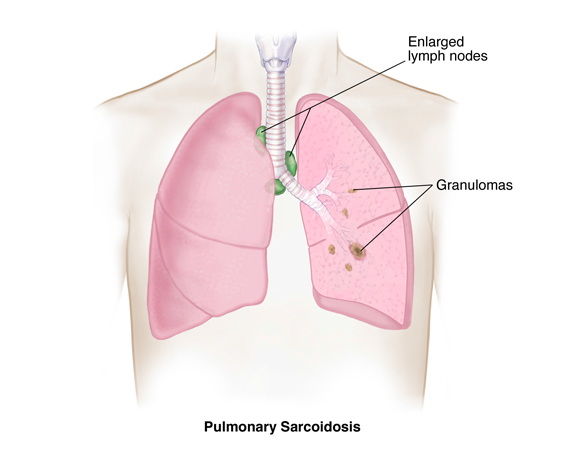Sarcoidosis (sar”koi-do’sis) involves inflammation that produces tiny lumps of cells in various organs in your body. The lumps are called granulomas (gran”u-lo’mahs) because they look like grains of sugar or sand. They are very small and can be seen only with a microscope.
These tiny granulomas can grow and clump together, making many large and small groups of lumps. If many granulomas form in an organ, they can affect how the organ works. This can cause symptoms of sarcoidosis.
Sarcoidosis can occur in almost any part of your body, although it usually affects some organs more than others. It usually starts in one of two places:
Lungs
Lymph nodes, especially the lymph nodes in your chest cavity.
Sarcoidosis also often affects your:
Skin
Eyes
Liver.
Less often, sarcoidosis affects your:
Spleen
Brain
Nerves
Heart
Tear glands
Salivary glands
Bones and joints.
Rarely, sarcoidosis affects other organs, including your:
Thyroid gland
Breasts
Kidneys
Reproductive organs.
Sarcoidosis almost always occurs in more than one organ at a time.
Sarcoidosis has an active and a nonactive phase:
In the active phase, the granulomas form and grow. In this phase, symptoms can develop, and scar tissue can form in the organs where the granulomas occur.
In the nonactive phase, the inflammation goes down, and the granulomas stay the same size or shrink. But the scars may remain and cause symptoms.
The course of the disease varies greatly among people.
In many people, sarcoidosis is mild. The inflammation that causes the granulomas may get better on its own. The granulomas may stop growing or shrink. Symptoms may go away within a few years.
In some people, the inflammation remains but doesn’t get worse. You may also have symptoms or flare-ups and need treatment every now and then.
In other people, sarcoidosis slowly gets worse over the years and can cause permanent organ damage. Although treatment can help, sarcoidosis may leave scar tissue in the lungs, skin, eyes, or other organs. The scar tissue can affect how the organs work. Treatment usually does not affect scar tissue.
Changes in sarcoidosis usually occur slowly (e.g., over months). Sarcoidosis does not usually cause sudden illness. However, some symptoms may occur suddenly. They include:
Disturbed heart rhythms
Arthritis in the ankles
Eye symptoms.
In some serious cases in which vital organs are affected, sarcoidosis can result in death.
Sarcoidosis is not a form of cancer.
There is no known way to prevent sarcoidosis.
Sarcoidosis was once thought to be an uncommon condition. It’s now known to affect tens of thousands of people throughout the United States. Because many people who have sarcoidosis have no symptoms, it’s hard to know how many people have the condition.
Causes
The cause of sarcoidosis is not known. And, there may be more than one thing that causes it.
Scientists think that sarcoidosis develops when your immune system responds to something in the environment (e.g., bacteria, viruses, dust, chemicals) or perhaps to your own body tissue (autoimmunity).
Normally, your immune system defends your body against things that it sees as foreign and harmful. It does this by sending special cells to the organs that are being affected by these things. These cells release chemicals that produce inflammation around the foreign substance or substances to isolate and destroy them.
In sarcoidosis, this inflammation remains and leads to the development of granulomas or lumps.
Scientists have not yet identified the specific substance or substances that trigger the immune system response in the first place. They also think that sarcoidosis develops only if you have inherited a certain combination of genes
Treatment:
In homoeoapthic nuber of durgs Treatment will be completely mental and totality of symptoms. I am giving you the no. of drugs which is treated by Best homoeopaths i.e aq. Mar, aren-ix, asar, beryl, hip acid. Hist. Kres, lepr, ugco, mard, nat. ars, parathyr, pin-s, puls, thiop, tub, tub-m, v-a-b.

